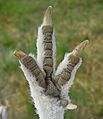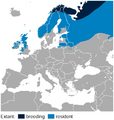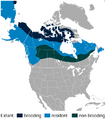Willow ptarmigan facts for kids
The willow ptarmigan is a medium-sized bird, about 15 to 17 inches long. It's a type of grouse that lives in cold, Arctic places. You can find it in areas with willow trees, open tundra (flat, treeless land), and muskeg (a type of boggy wetland).
Its feathers change color with the seasons. They are brown in summer to blend in with the ground, and then turn white in winter to hide in the snow. This bird is very common in many parts of Alaska.
Contents
What is a Willow Ptarmigan?
The willow ptarmigan is a fascinating bird known for its amazing ability to change its feather color. This helps it stay hidden from predators like foxes and eagles. It's the official state bird of Alaska.
Where Willow Ptarmigans Live
Willow ptarmigans live in the northern parts of the world. They are found across North America, Europe, and Asia. They prefer cold, open areas. These birds often live near willow bushes, which provide both food and shelter.
Habitat in Different Seasons
In summer, willow ptarmigans live in areas with dense willow thickets and other low-growing plants. These plants offer good cover and food. When winter arrives, they move to more open, snowy areas where their white feathers help them disappear into the landscape.
Willow Ptarmigan Diet
Willow ptarmigans are mostly plant-eaters. Their diet changes with the seasons, depending on what food is available.
Summer Foods
During the summer, these birds eat a variety of plant parts. They enjoy eating leaves, flowers, berries, and seeds. Young willow ptarmigans also eat insects, which provide important protein for their growth.
Winter Foods
In winter, food becomes harder to find. Willow ptarmigans mainly eat the buds, twigs, and catkins (fuzzy flower clusters) of willow and birch trees. Their strong beaks are perfect for nipping off these tough plant parts.
Life Cycle and Reproduction
The life cycle of the willow ptarmigan is adapted to the harsh Arctic environment. They have specific ways of finding mates and raising their young.
Mating and Nesting
Willow ptarmigans usually start looking for mates in late spring. The males often perform special displays to attract females, including flying high and making loud calls. Once a pair forms, the female builds a nest on the ground. The nest is usually a shallow dip lined with grass, leaves, and feathers.
Eggs and Chicks
A female willow ptarmigan typically lays 6 to 10 eggs. The eggs are usually yellowish or reddish with dark spots. The female does most of the incubation, which means sitting on the eggs to keep them warm until they hatch. This takes about 20 to 23 days. Once the chicks hatch, they are covered in downy feathers and can leave the nest very quickly. Both parents help to care for the young chicks.
Adaptations for Cold Weather
Willow ptarmigans have several special features that help them survive in very cold temperatures and snowy conditions.
Feather Changes
Their most famous adaptation is their feather color change. This is called seasonal molting. In spring, they shed their white winter feathers and grow brown ones. In autumn, they shed their brown feathers and grow white ones again. This helps them stay camouflaged all year round.
Feathered Feet
Unlike many other birds, willow ptarmigans have feathers on their feet and toes. These feathers act like snowshoes, helping them walk on top of snow without sinking. They also provide extra warmth, protecting their feet from the extreme cold.
Images for kids
-
Distribution in Europe
-
Distribution in North America
See also
 In Spanish: Lagópodo común para niños
In Spanish: Lagópodo común para niños







